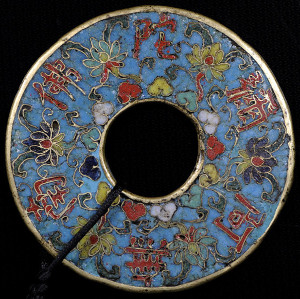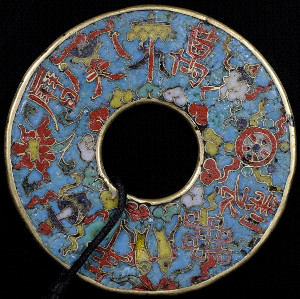The vast majority of old Chinese charms are made of bronze or brass. Towards the end of the imperial period, charms made of silver also became popular.
Cloisonne is an ancient method of creating colorful designs on metal objects. Small silver or gold wires are soldered onto a metal object and the areas within the wire design are filled with enamel after which the object is fired in a kiln.
The technique began to appear in China during the fourteenth or fifteenth century and the earliest reliably dated Chinese cloisonne objects date to the early Ming Dynasty (1368-1644).

Chinese cloisonne charm displaying the Eight Buddhist Treasure Symbols and inscribed “nan wu a mi tuo fo”.
At the left is a rare Ming dynasty cloisonne charm (明代景泰蓝花钱).
The Chinese inscription is written in large red enamel characters with gold wire outline. The inscription is read in a counter-clockwise manner, starting at the 8 o’clock position, as nan wu a mi tuo fo (南無阿彌陀佛) which translates as “I put my trust in Amida Buddha“.
Between the Chinese characters are various colored lotus blossoms. The colors have different associations.
A white lotus represents the womb of the world from which all things emerged. It also symbolizes the state of total mental purity and spiritual perfection.
The white lotus is also associated with the Ming Dynasty. Zhu Yuanzhang (朱元璋), a military leader of the White Lotus Society (白蓮教), led a rebellion that resulted in the establishment of the Ming Dynasty in 1368 with himself enthroned as the Hongwu Emperor (洪武帝).
A pink lotus represents the Gautama Buddha, the historical Buddha.
A red lotus represents the original nature of the heart and symbolizes love, compassion and passion.
A blue lotus symbolizes wisdom, knowledge and victory of the spirit over the senses.

Chinese cloisonne charm displaying the Eight Buddhist Treasure Symbols and inscribed “Made during the reign of Wanli”.
The Chinese inscription in large red enamel characters with gold wire outline on the reverse side of the charm is also read in a counter-clockwise manner.
The inscription, beginning at the 1 o’clock position, reads wan li nian zhi (萬歷年制) which translates as “Made during the (reign) of Wan Li”.
The Wanli Emperor (万历) was the thirteenth emperor of the Ming Dynasty and reigned during the period 1572-1620.
The Wanli Emperor was a strong patron of Buddhism.
Interspersed between the Chinese characters are the Eight Buddhist Treasure Symbols (八吉祥, 佛教八宝) also known as the Eight Auspicious Symbols.
Beginning at the 12 o’clock position and moving clockwise, is the ceremonial umbrella or parasol (阳伞). The parasol symbolizes high rank. People of high rank or royalty were protected from rain and sunshine by servants holding a parasol. In Buddhism, this symbol of wealth and power takes on the meaning of spiritual power.
The conch shell (螺, 白海螺), at the 1 o’clock position, is used to call Buddhists together for an assembly. The conch shell therefore symbolizes the true teachings and also the voice of the Buddha.
The wheel or flaming wheel (法輪), at the 3 o’clock position, represents the Wheel of Law or dharma which is the teachings of the Buddha. The eight spokes symbolize the Eightfold path. The perfect circular form represents the completeness and perfection of the Buddha’s teachings. The wheel also represents the unbroken chain of births and rebirths.
The endless knot (吉祥结, 无尽结), at the 5 o’clock position, represents long life, eternal love and the interconnection of all things. The endless knot has no beginning or end and therefore symbolizes the infinite knowledge of the Buddha.
The pair of fish (双鱼; golden fish 两只金鱼), at the 6 o’clock position, symbolize fertility and salvation from suffering.
The treasure vase (Urn of Wisdom 宝瓶), at the 8 o’clock position, symbolizes spiritual abundance and the fulfilment of spiritual wishes.
The lotus (莲花), at the 9 o’clock position, represents mental purity. Just like the lotus flower that rises up from the depths of a muddy pond to blossom above the water’s surface, all sentient beings have the potential to attain buddhahood.
The victory banner (state canopy 胜利幢), at the 11 o’clock position, represents spiritual authority, victory over ignorance and evil, and the protection of the Buddha.
Cloisonne only began to appear in China during the Ming Dynasty. Cloisonne charms dating from that period are very rare.
For more information and examples of Chinese Buddhist charms, please see Buddhist Charms.